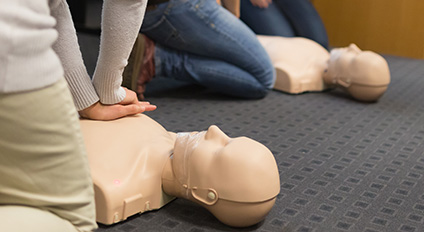

Occupational health and accidents
First aid preparedness
First aid preparedness at the workplace means that the workplace has enough people with first aid skills in relation to its circumstances, the necessary first aid equipment and guidelines for emergency situations.
The first aid preparedness section replaces the Occupational Safety and Health Administration guide "First aid readiness at workplaces. Occupational safety and health guides and instructions 33”.
General information on topic
The employer must ensure that the necessary first aid is available for employees and other persons at the workplace. Employees must be given instructions on what steps to take if they need first aid in the event of an accident or illness.
A workplace must have a sufficient number of appropriate first aid equipment in easily accessible and clearly indicated locations. A designated space where first aid can be administered must be provided if necessary due to the number of workers, the nature of the work or other circumstances in the workplace.
One or more employees must be assigned as first aid coordinators, and these individuals must be properly trained and given any necessary equipment.
The employer and the occupational health care professionals determine the necessary level of first aid preparedness
The employer and the occupational health care professionals determine the need for first aid preparedness as part of occupational health cooperation. The planning of first aid preparedness is based on this assessment. The required first aid skills, the number of persons receiving first aid training, content of the courses, and the first aid supplies needed are specified in the planning.
If necessary, representatives of civil defence organisations and rescue services can be consulted. Planning will take, in particular, emergency preparedness for major accidents into consideration.
The process also includes establishing a procedure for dealing with post-traumatic stress resulting from work or incidents in the workplace.
Instructions for employee
The skills acquired through first aid training are useful both in the workplace and in leisure time. Every person has a duty to help others in the best possible way - but without endangering themselves or others. It is a good idea to seize the opportunity if your employer offers on-the-job first aid training.
At the workplace, the employer is responsible for arranging adequate first aid preparedness taking into account the nature and circumstances of the workplace. However, each employee has an obligation to contribute to first aid preparedness.
- Read the first aid and rescue instructions for your workplace.
- Find out where the first aid supplies and equipment are located (first aid cabinets, defibrillator, plaster points, eye irrigation supplies, emergency showers, etc.)
- When necessary, call the emergency number 112 (or the control room or gate, etc.) for help
- Explain what has happened.
- Provide the location where the accident has happened and directions on how help can get there.
- Notify the employer if you notice any deficiencies in first aid supplies or equipment.
Instructions for employer
The employer is responsible for arranging adequate first aid preparedness for the workplace. Occupational health care has a duty to assess the need for first aid preparedness at the workplace and to determine an adequate level of first aid preparedness (including the number of people with first aid training, the content of first aid courses and the number and quality of first aid supplies). In order for occupational health care to be able to carry out an assessment, the employer must provide sufficient information on the workplace, the working environment, the work carried out there and on everything that is relevant in the assessment of first aid preparedness.
When planning the number of people receive first-aid training, consideration should be given to how the work is carried out. If the work is carried out in shifts, for example, the work shifts must be planned in such a way that each shift has sufficient first aid readiness.
The nature of the work can be mobile, work can mainly be done in shared workplaces, or one's own workplace can be a shared workplace where the employees of many different employers work.
Each employer is responsible for their own employees and the safety of those employees. When planning first aid preparedness, no one can rely on sufficient first aid preparedness having been arranged by another employer. In shared workplaces, the employer or builder/main contractor exercising main control is responsible for ensuring that the workplace has a adequately planned and implemented general first aid preparedness and that adequate information on these measures and instructions has been provided to all those working in the area.
Initial data that impacts first aid preparedness is very important. A sufficiently comprehensive investigation and assessment of the hazards related to the work and working environment must be conducted. Other relevant factors, such as hazardous chemicals, processes, machinery, air pollutants, explosive hazards, etc., must also be investigated.
Legislation
Occupational Safety and Health Act (738/2002)
- sections 8, 10, 44 - 47
Government Decree on the Safety of Construction Work (205/2009)
- chapter 14
Government Decree on Chemical Agents at Work (715/2001)
- sections 4 - 6 and 11
Government Decree on the safety of tree harvesting (749/2001, in Finnish)
- sections 3 and 13
Occupational Health Care Act (1383/2001)
- sections 12, 15 and 17
- sections 4, 6, 10 and 11.
Government Decree on the Occupational Safety in Loading and Unloading of Ships (633/2004)
- section 22
Act on Ships’ Medical Stores (584/2015)
Ministry of Transport's decision on the structure and equipment of buses and coaches (637/1990) section 35 and Appendix 7 (The decree in question was repealed on 29 April 2009, but it still applied in these respects under section 2, subsection 5 of Decree 257/2009
Glossary
This website is part of the European Commission's Your Europe portal. Did you find what you were looking for?



